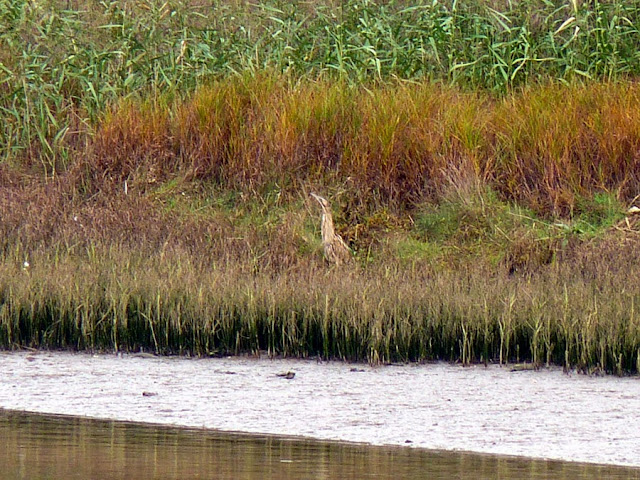Thought it was about time I wrote a blog post! I've certainly got a fair bit to write about, so I'll try and keep it brief and put in plenty of pretty pictures.
To start with, let's rewind a week to Bank Holiday Monday. Just before Jess and I were heading out for the day I received a phone call from Sue Smith who thought she had a
Black Tern on Black Hole Marsh. I was there in a shot (half way through shaving!). Thankfully the Tern remained, although only just - it flew off north about a minute after I arrived! It looked quite a pale one to me, and I don't remember ever seeing a juv
Black Terns with a pale brown mantle (they've always appeared dark to me), but it was just a
Black Tern. Not that that's a bad thing though as they're really scarce on patch - so a very welcome patch year tick. See pics
HERE and
HERE.
So I headed off to Sherbourne for the day a happy chappy. And totally unrelated to anything else on this post, look what we saw...
 |
| A gold post box! |
And if you can't remember why there's these gold post boxes around...
 |
| I saw him win this medal....on telly. Well done Peter! |
The following day saw me rushing down to Black Hole Marsh again, this time for a juv Little Gull seen from the Tower Hide. Sadly I was about five minutes too late despite my fastest sprint from the car park to the hide! Oh well, you win some you loose some. I did see a juv Cuckoo though, and am sure it is a second bird as to me it seemed a lot more rufous than the the first bird (which hadn't been seen for at least a week before).
I didn't have much birdie time last week, but when I did (except for the Tern and Gull twitch) I went in search of autumn passerine migrants, hoping for a rare warbler, Ortolan or Wryneck. Sadly none of these materialised with my best find being a juv Osprey over Beer Head on Wednesday 28th. I first picked it up just offshore after the gulls went up from the camp site, then it came in and flew west right over our heads - luckily Karen and Ian weren't far away.
 |
| My first of the autumn |
Also on Beer Head on Wednesday morning were: 35 Yellow Wags, 26 Wheatear, 5 Chiffchaff, 2 Willow Warbler and singles of Grey Wag, Tree Pipit and Whinchat. Despite these fairly good counts, they all felt like lingering migrants from the weekend/bank holiday fall.
 |
| There's a Whinchat in the lower pic |
Thursday morning I thought I'd give Axe Cliff it's first visit of the autumn. No good to be honest as they haven't cut the crop yet so Ortolan potential = zero! Still, I had three Tree Pipits and a Yellow Wag over and a few Wheatear and a Spotted Flycatcher on the deck, so it wasn't a total waste of time.
Saturday saw me give Black Hole Marsh a proper look for the first time for over a week! It was the first time I saw the 'Curlew Sandpiper show' with at least 15 juveniles scattered about amongst the Dunlin and Ringed Plover...
 |
| Some are coming stupidly close to the hide too! |
Also present were two Little Ringed Plovers, a Ruff and this juv Turnstone...
 |
| Taking time out from stone turning and having a bit of chill time! |
This afternoon I gave Black Hole Marsh another look. On the marsh was a similar selection of birds to Saturday, but a trip to the Tower Hide was certainly worthwhile. I thought I heard Spotted Redshank call shortly after I arrived, and soon spied two likely suspects roosting up river from the Tower Hide, both clearly juvs. I got everyone on to them (everyone who was interested anyway!) but we had to wait a little while until we saw some head and bill - they were clearly very sleepy! The rising tide pushed them about which allowed me to get this superb flight shot...
 |
| You won't see any better flight shots than this! |
They eventually moved on to Black Hole Marsh and mingled with the Blackwits and Redshank.
Just before my visit to Black Hole Marsh I had a look around Lower Bruckland Ponds. Whenever I go here I always spend a lot longer wandering around than I was planning too as there's always so much to see and photograph! Best of all today were a couple of lovely male Ruddy Darters...
 |
| Check out that body shape! Is that what they call an hour glass figure!?? |
I don't think I normally see Golden-ringed Dragonflies this late in the year, but have seen plenty recently including this showing one at LBP today...
 |
| One of my favs these |
Along with the expected
Migrant Hawkers...
 |
| The dragonfly of the autumn |
It's not just dragonflies that distract me here, because as always there were lots of butterflies too. The best being the second flight period of Dingy Skippers...
 |
| Dull but sweet! |
American waders are turning up all over the place at the moment - so I know where I'm going to be doing most my birding over the next week....












































